Location: Bellari district, >350 Kms from Bangalore
Route: Bangalore – Hospet– Hampi
We were: Nisa, Sanjeev and myself
Hampi was always in our minds. We have been thinking about visiting Hampi. The only thing that kept us away, was its enormity. After we visited Hampi, that is still the most striking thing in mind – Enormous. Grand. Magnificent.
Why visit Hampi? Why should one walk endlessly in scorching sun from stone to stone?
The reasons are many, but most of it relates to themes of History, Myths & Legends and Art & Architecture. If you are interested in any of these, this place is a must visit.
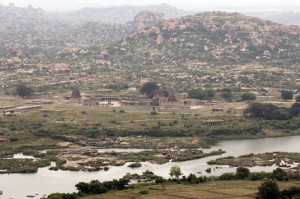
The huge boulders around you would take you back in time…
The temples and shrines strewn around would tell you stories…
The majestic ruins would leave you awestruck…
Planning for Hampi
Do not plan a leisure trip, this could be one of the most tiring trips for you. Book tickets and accomodation and start reading – all about Hampi. That sets the right mood. Download a map of the ruins to plan what all must not be missed.
How long – Plan minimum 3 days. They would be thickly packed.
How to travel – Overnight journey, from Bangalore, in Train (recommended) or bus to Hospet. Then shared auto-rikshaws or buses to Hampi. Within Hampi, on the first day take a guided auto-rikshaw tour. There are many available for Rs. 500/- to 600/- for a full day. Don’t worry, seeing tourists they would come and ask you or your hotel can also arrange one. Do take a guide to explain each rock that you see, even if the exaggerate a bit, you can sieve through later. This gives an overview, the big picture. On the next days, hire a bike or motor bike that can take you at least till motorable limits to visit the places in more detail. Be ready to stop in between; because there are architectural ruins all around you; there are sculptures on any rock. They say Hampi must be enjoyed by walk starting from the Archeology museum in Kamalapur; but this is not practical for a short trip.
What to carry – everything to protect you from the scorching sun – caps, sun-block-creams, cotton airy clothes, extra clothes if you want to take a dip in Tungabhadra, umbrellas (that can double up as walking sticks!). Keep some snacks with you, that keeps you going.
Where to stay – Hampi is just another village, with no luxurious resorts. But there are some good optios – we enjoyed the stay in Shanti guesthouse, across the river at Virupapur Gaddi. Just basic accomodation with a neat room and toilet, very close to all Hampi ruins, very warm and flexible hosts, with very relaxing open greenery and good international food – Israeli, Spanish and German. A bath in the crystal clear Pampa, after a day in the scorching sun is remarkable. Though we didnt get advance accomodation through phone, when we reached there they could arrange a room for us.
The entire street of Virupapur Gaddi is remarkable! Even if you do not stay there, do visit this place across the Pampa river – a street full of guesthouses that caters to European and American travellers, you hardly get good Indian food here. Do try the pizzas that are freshly baked in the traditional wooden ovens! I remembered the ones in Florence! The evenings are really relaxing here, especially Mowgli guesthouse, but there is no ferry back after 6.00 PM to get back to Hampi.
Historically speaking
If you are historically inclined, read about Vijayanagara before you start. Recommendations:
– A Forgotten Empire (Vijayanagar): a contribution to the history of India by Nunes et al.
– New Light on Hampi: Recent Research at Vijayanagara by George Michell and John M. Fritz.
– Do read Vijayanagara Research Project.
– While in Hampi do visit the free photo exhibition near the Monolithic Bull for the Before and After. To see how much of effort has gone into bringing this empire back in its shape.
This rocky region has been dated back to pre-historical times, with some of the boulders believed to be part of the super continent we had in the beginning. There are also cave paintings on the nearby Anegundi by stone age men and women. However the most important part of history for Hampi is Vijayanagara empire. Hampi houses the largest and earliest known palace structures, now in ruins.
In 14th century Hampi was the capital of an emerging Vijayanagara empire which in 200 years, consisted of all the land downwards from Orissa. There was a golden period of Krishnadevaraya, when Hampi was the land diamonds, art, literature and architecture. Remember Purandara Dasa, Tenali Rama and many faceless artists who brought heavens downwards. Later, in the Battle of Talikota, the empire was lost to the neighbouring Deccan sultans, who were irritated by the obstinacy and arrogance of the emporers. The kings and noble men fled with whatever riches they could carry on elephants, the travelling gypsies took whatever they could and the rest were plundered and burnt down by the victorious Sultans. Later Maratha invaders, Tipu Sultan and Britishers came and went adding more confusion to the ruins.
What we know about the empire now is only from what is recounted in the European travelogues and some writings on stones – a land of richness and grandeur, with beautiful gardens and water management system, celebrating grand processions and festivals, promoting art and literature. Whatever I read, I could read only richness:
– rich sculptures for each victory of an emperor carved on to wood and stone in the same easiness
– rich noble men who quarried diamonds and precious stones that were offered to the King before being sold in the open bazaars (Yes, in open Paan Supari streets)
– rich soil that was leased out to farmers to make the kingdom food sufficient.
From 1980s onwards, Archeological Survey of India (ASI) started a massive project to unearth this forgotten empire from its ruins, from under banana cultivation, creeping wildnerness and new habitations.
- What is remaining of the palace with elaborate pools and prayer areas
- Hampi Bazar with new inhabitants and tea shops for tourists. ASI has started to remove the modern additions, much to the anger of the present inhabitants
- Hampi Bazar – a building without much modification. Probable all buildings would be restored to this condition
- ASI in work to restore one of the buildings, near Courtesans’ street. It has been a remarkable project!
- Recreated courtesan street leading to Achutacharya temple. With beautiful sculpted pillars and ponds…Contrary to the majesty of all other ruins, these are too narrow rooms or houses for decent living.
- A dried pond next to Courtesan’s street. No wonder that early European travelogues describe Hampi as a place of gardens and beautiful tanks.
- We bumped on this man who came with us to explain the tombs of early Vijayanagara kings. Quite surprised and totally out of our itinerary. We couldnt go further, as there were some confidential meetings of some (Hindu?) groups were ongoing.
- Archeological Survey of India has done a great work in unearthing these ruins under banana plantations and laying them out as they stood in the past.
- Rocks, Ruins, River
Mythologically speaking
Everywhere in Hampi, you see that the main idols of worship are either Shiva or Hanuman. So here are the legends associated:
– One side of the river Pampa, has Virupaksha temple. You get to hear and see stories of how Pampa fell in love with Shiva (Lord of matted locks, as he was called before identifying with Shiva), Manmatha helped her to win Shiva’s heart and finally they got married amidst showers of gold in Hemakuta (Heap of gold) hill.
– On the other side of the river Pampa is the monkey kingdom of Kishkindha, with stories from Sugriva’s cave, Sita’s kidnap and Hanuman’s birthplace.
Architecturally speaking
This is what struck me the most – The magnificence and majesty of the buildings, or whatever is remaining of them. You see a line here, a mount there in any stone that you bump into; and in Hampi you always bump into them!
– Abstract Shiva linga shapes
– Detailed images of valiant men dead in battles
– Symbolic hands of Sati women who died on the pyre of their husbands lying around in any rock anywhere.
And those beautiful temples and deities which have not been destroyed – they are true testimony to what it would have been if all the other buildings were also surviving. What a mastery of art! What a precision of planning! There have been studies recently that have also discovered that all these buildings are spatially distributed in precise axes from the holy Matanga hill – at a time when telescopes were unheard of.
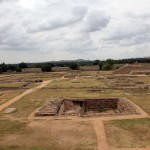
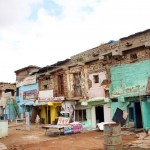
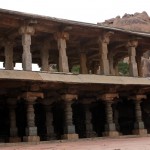
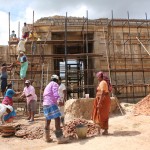
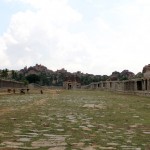
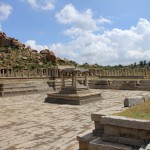
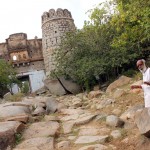
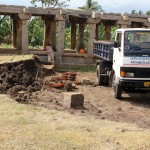
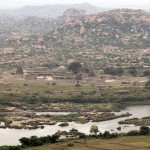
Smrti!!!!!!!!!!!!!! Great place….Hampi…thanks for your recommendation….Soaked in the history…Gorged in the food at Mango Tree…and had the most blissful of sleep in Shanti….I would definitely recommend it to anyone (during Winter :-)).
Amel, happy to know that you liked Hampi….Soaked, gorged and blessed!
We would plan a trip together later!
Hey smrti,
Would love to visit this place, more so tempted after reading your blog :), very well written. For the Place, yes, hampi is supposedly a very intriguing place, a friend had once told me that Hampi is one of the places which , either you leave a part of you there or carry a part of hampi wht yourself. Your blog only re-affirms it :).
Thanks Shruthi. What your friend said is so true!
Smrti
Amazingly written blog!!
Thanks Manojt.
Hi…beautiful narration of hampi and great pictures.
Do you have any alternate number of Shanthi Guest House…the one on their website is coming switched off.
Thanks…really
Hello Ishani,
Thank you.
I do not have any other numbers of Shanti Guest House.
Smrti
Hi Smrti,
Nice effort and good throughts about the places you have visited.I am from Bangalore and run my resort in Coorg for the last 5 years, please visit http://www.greenvalleyresort.in and let me know if you wish to take a break in Coorg.
Wish to hear from you.
Best
Simha
+91 93428 33848
Thanks Simha for the invite. Surely will remember this, on our next Coorg trip
Smrti
Great !!!! Many many thanks to u for this informative travelogue. you have inspired mt to travel Hampy and Bijapur.
I have been turned into a follower of u. Your writings are attractive.
Keep it on.
Thanks a lot Jamil Sayed, I’m flattered!
Hampi is a really good place to visit
This is a unique travelogue dedicated to exploring historical and cultural experiences. I love these stories featuring the historical, archaeological, mythological and cultural aspects of a destination.
I am little overwhelmed by how many ways you traveled, restaurants you ate at and tourist attractions you enjoyed.
Your travel experience has inspired me to visit Hampy and Bijapur. Many many thanks to you.
I am from Kolkata and a travel buff.
Thank you Jamil. Do visit Hampi and Bijapur, you would love it!
Smrti